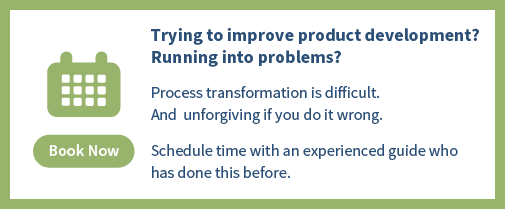Running a daily standup meeting seems pretty simple right? After all it’s just another meeting. Well not really. The daily stand-up process is important. Just like in football, a great huddle or stand-up meeting should leave team members prepared for their next action, clear on their number one priority for the day, energized and armed with the tools they need to get it done.
So what makes a kick-ass daily stand-up meeting? And what are the warning signs that yours is going awry? Check out the ten tips below for how to run a daily stand-up meeting. And don't forget to download your free daily huddle agenda at the end of this post as well as share the video.
10 Tips for How to Run a Daily Standup Meeting
-
What is the purpose of a daily standup meeting?
The purpose of the stand-up is first and foremost to improve communication and project flow through faster feedback. Feedback every 24 hours increases project velocity and enables the team to make quick adjustments in order to keep the project flowing smoothly. By contrast, waiting one week to get the information you need is 7 days too late to make a difference.
-
The standup meeting leader is key
Running an effective meeting needs a good quarterback. Good quarterbacks know whether to run the ball or pass in order create a successful drive down the field. They know the players, the playbook, and they know how to clear a path to the end zone. When the huddle breaks, everyone knows exactly what needs to be done today to win the game.
-
Questions to ask in a daily standup meeting
The topics discussed during the daily scrum include which play to run and who will be running it. In other words, what task is on the critical path and who is doing it. As well as if there is anything blocking the work on the critical path. Handoffs are also critical. You don't want to drop the ball while handing off to the next critical task.
Importantly, the daily scrum is not a status meeting. And it's not a meeting for in-depth technical discussions – offline ‘em! The daily huddle is about the next activity that needs to be undertaken to keep the project flowing smoothly!Interested in understanding more Lean-Agile Principles? Check out our free Lean-Agile training on Playbook Academy such as Rolling-Wave Planning, Applying Agile to Hardware and Critical Chain.

-
Cadence of your daily standup is important
We recommend meeting every 24 hours - no longer than 15 minutes. Some teams meet every other day (M, W, F). To us, this is the minimum. Any longer between meetings and the team misses out on fast feedback. The result? Project velocity will slow down.
-
Re-prioritize work loads
Everyone wants to do a good job. But team members are often overwhelmed with work from competing projects. Daily meetings are useful for ensuring priorities are clear and correct, and for shifting work. If a team member is overloaded, they might be working on the wrong thing and critical tasks may get unnecessarily delayed. Use the time during the daily huddle to ensure team members’ priorities are clear and correct and they are not overloaded. Playbook is the only tool on the marketing that gives clear and correct priorities daily. Watch this short video to find out the number one cause of project delays. It's not what you think!
-
Dedicate time, space and equipment to your scrum meeting
Finding a time that works for the team, reserving a meeting room, finding a computer and a working projector all take time. It wastes peoples' time. Best to have a regularly scheduled meeting time and a dedicated project room that is already set up for action. One click and the team is up and running! Dedicated project rooms are also available to the project team for impromptu meetings and discussions. At companies like Spectranetics, they have the right idea. Check out this case study.
-
Instill a heightened sense of urgency in your daily standup
Part of the reason why daily stand-up meetings are 15 minutes or less is that it's important to instill a sense of urgency so team members don’t get off track. The meetings need to be on point and effective. When you run your huddle, team members should feel energized.
-
Weekly rolling wave planning
Daily huddles or stand-up meetings work best when combined with weekly rolling wave planning [video]. To use another analogy, daily stand-ups are the little corrections you make while driving a car, helping you to avoid potential threats where you are right now. Weekly rolling wave planning is when you look up and take a slightly longer distance view, so that you’re better prepared for threats unfolding up the road farther ahead.
-
Kanban boards are good, but visual project management software is better
Teams that meet every day using only a project board never have a complete picture of how their tasks fit into the overall plan. They can’t see the details in context of the overall schedule. This is one of the features that sets Playbook apart. It gives teams both a Kanban view and a Gantt chart view of the plan.
-
Meet face-to-face
If possible, meet face-to-face. People naturally communicate more when they are physically close. Companies like Google offer free meals to increase connection across the organization, chance encounters and impromptu meetings. Meeting face-to-face also builds a better sense of community.
When should you reevaluate your approach to your daily stand-up meeting?
If people aren’t getting useful information from the daily stand-up meetings, the meetings will begin to be perceived as a waste of their time. They will stop attending. This is the first symptom of a waning stand-up meeting.
Once one person stops attending, like a house of cards, attendance dwindles. If core team members aren’t there, the meeting is a bust.
Keep an eye out for warning signs and re-evaluate your approach to daily stand-ups! They are worth the investment.
----
Daily standup agenda
Ready to conduct your daily stand-up meeting? Here's a free agenda for running your daily huddle meeting.
Watch the Video: How to Run a Daily Standup Meeting
Related articles
Lean project management methodology
What is rolling wave planning?
Lean project management Kanban
Lean project management principles
Lean project management resource management
Lean project management Pull vs. push
Lean project management task management
Lean project management and shared project buffers
Lean project management and decentralized planning
Daily stand-up meetings
Guide to Lean Project Management
Guide to Kanban





